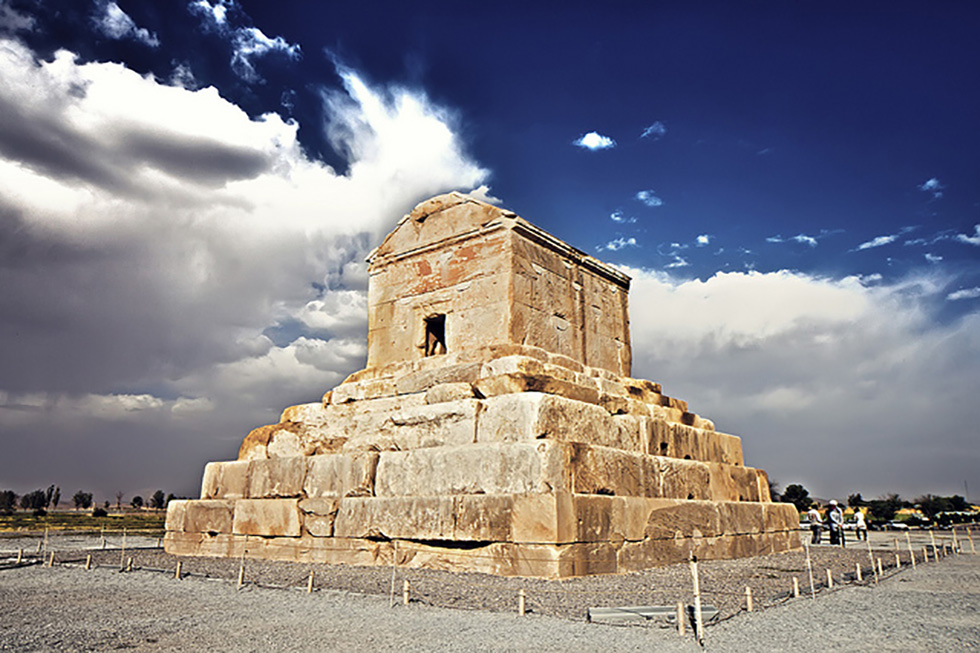pasargad
Begin With the Tomb of Cyrus which is know locally as Qabr-e Madar-e Solaiman ، tomb of the Mother of Solomon ، a name most likely bestowed on it at the time of the Arab invasion.
The building is set upon a stepped plinth recalling a Mesopotamian ziggurat , while the gabled tomb chamber bears at least some resemblance to funerary monuments from Phrygia and Lycia. But its massive ، megalithic masonry reinforced by swallow-tail clamps of lead and iron , is as Stronach has pointed out , completely Achaemenian in character.
The stone base measures 13.50 ×12.20 m.and the sepulcher itself is 5.24 m.
Long and 5.30 m. wide and a bout 6 m. high , the original height of the structure being nearly 11m.
In 1970 , when Mr . Stronach was taking fresh measurements on the roof of the tomb , he discovered a hitherto unnoticed feature on the topmost stone of the gable above the door.
This consister of the lower half of a much eroded , rayed disc about 50cm . in diameter.
Possibly this symbol provides an important club to the religious beliefs of Cyrus himself.
Visitors may not enter the tomb chamber which is empty. One can , however , glimpse thr interior through the open doorway in the later afternoon.

It is entered by a small passage from the doorway , originally closed by double doors pivoting in sockets on either side of the frame.
A shallow mihrab or prayer niche was cut into the south wall about 700 years ago when , under the Atabak sad Ibn Zangi , who died in A.D.1226 , various columns from the palaces were used to from an arcade round the base of the plinth , the monument then being transformed into a congregational mosque.
Later still , more stone was brought from the palaces and elsewhere to construct the caravanserai that was excavated by the Iranian Archaeological Service.
The columns have been removed and are being restored to their original positions.
Originally the Magi , guardians of Cyrus tomb lived within the surrounding gardens in a separate dwelling.
The interior of the mausoleum , according to Ariyan , was richly furnished , the embalmed body of the king lay in a golden sarcophagus on a gold couch , with a gold table by its side , on which various treasures were laid. Alexander the Great made several pilgrimages to the tomb.
Various classical writers mention an inscription on the tomb , no trace of which remains.
According to Strabo this read : O man , I am Cyrus who founded the Empire of the Persians and was king of Asia.
Grudge me not therefore this monument.
From the tomb of Cyrus the road leads north-east passing the Residential palace on the left , and ending at the Audience Hall. Both palaces were surrounded by protective walls until 1971 and are built on the oblong plan in contrast to the later , square plan of the Persepolis palaces.
Only one tapered column of the original eight stands in place in the lofty central hall of the Audience Palace (or Palace S) , stork nest in permanent occupation on its top.
Originally double-horned lion protomes formed the capital. Four low-ceilinged porticos were also supported by columns , 48 supporting the northern colonnade.
On the doorways of Palace S , bas-reliefs of partly Assyrian inspiration can be seen , while on the south-east corner a stone shaft bears a cuneiform inscription in old Persian , Elamite and Babylonian , reading , I am Cyrus , the King , the Achaemenian.
Black and white limestone has been used with telling effect in both palaces and the doorways are also of black limestone , but exposure is beginning to damage the stone.
